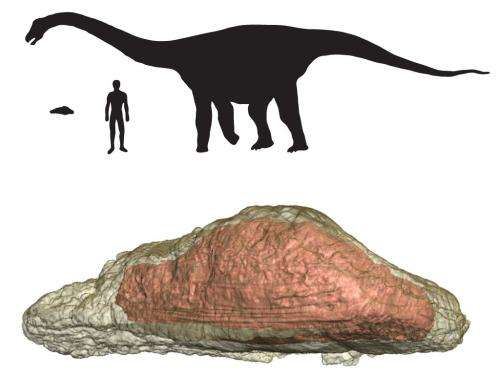'Skin bones' helped large dinosaurs survive, new study says

Bones contained entirely within the skin of some of the largest dinosaurs on Earth might have stored vital minerals to help the massive creatures survive and bear their young in tough times, according to new research by a team including a University of Guelph scientist.
Guelph biomedical scientist Matthew Vickaryous co-authored a paper published today in Nature Communications about two sauropod dinosaurs — an adult and a juvenile — from Madagascar.
The study suggests that these long-necked plant-eaters used hollow "skin bones" called osteoderms to store minerals needed to maintain their huge skeletons and to lay large egg clutches. Sediments around the fossils show that the dinosaurs' environment was highly seasonal and semi-arid, with periodic droughts causing massive die-offs.
"Our findings suggest that osteoderms provided an internal source of calcium and phosphorus when environmental and physiological conditions were stressful," he said. As a researcher in the Department of Biomedical Sciences in Guelph's Ontario Veterinary College, Vickaryous studies how skeletons develop, regenerate and evolve.
He worked with paleontologist Kristina Curry Rogers and geologist Raymond Rogers at Macalaster College in Minnesota, and paleontologist Michael D'Emic, now at Georgia Southern University on the study. Vickaryous helped to interpret the results of CT scans and fossilized tissue cores taken from the dinosaurs.
Shaped like footballs sliced lengthwise and about the size of a gym bag in the adult, these bones are the largest osteoderms ever identified. The adult specimen's bone was hollow, likely caused by extensive bone remodelling, said Vickaryous.
Osteoderms were common among armoured dinosaurs. Stegosaurs had bony back plates and tail spikes, and ankylosaurs sported heavily armoured bodies and bony tail clubs. Today these "skin bones" appear in such animals as alligators and armadillos.
Such bones were rare among sauropod dinosaurs and have appeared only in titanosaurs. These massive plant-eaters included the largest-ever land animals. "This is the only group of lon-necked sauropods with osteoderms," he said.
Other studies have shown that female titanosaurs laid dozens of volleyball-sized eggs. Modern crocodiles and alligators also lay clutches of dozens of eggs and are known to reabsorb minerals from their osteoderms.
The researchers found the new osteoderms along with two skeletons of the titanosaur Rapetosaurus. Unlike the hollow adult specimen, the juvenile specimen was solid and showed little evidence of remodelling. That suggests that osteoderms became more important mineral stores as the animals grew, Vickaryous said.
More information: Paper online (pdf) www.macalester.edu/dotAsset/3e … 426-d45116be33aa.pdf
Provided by University of Guelph


















